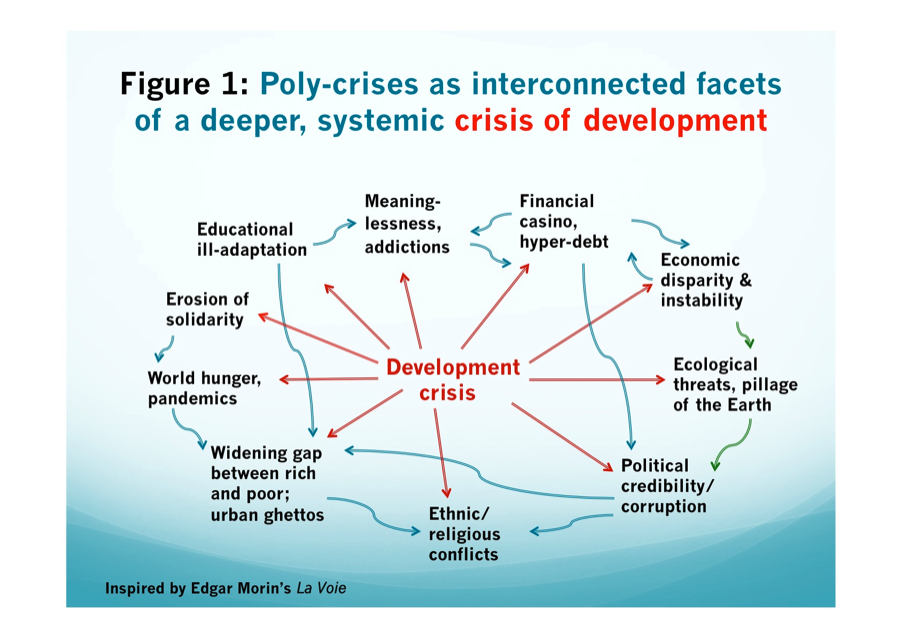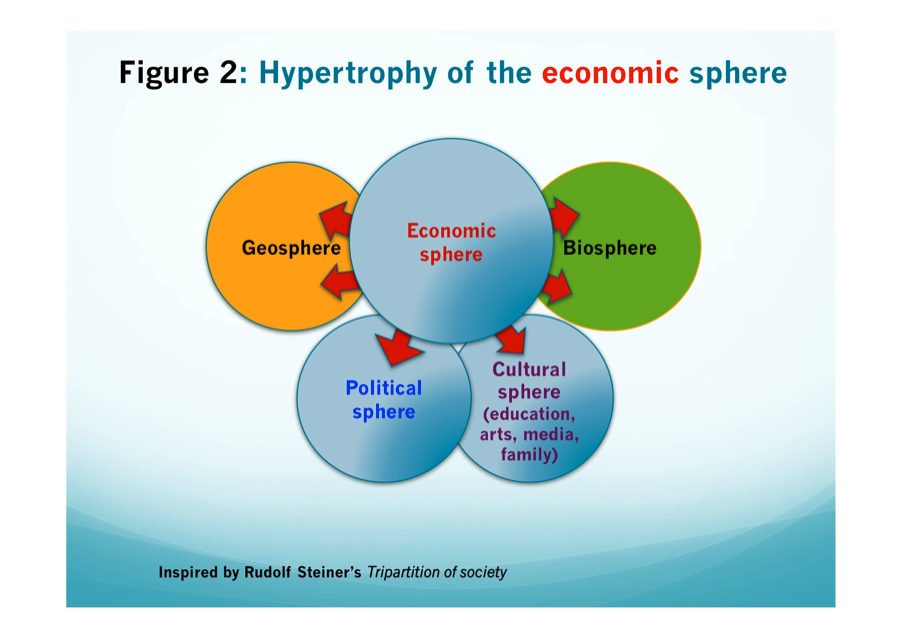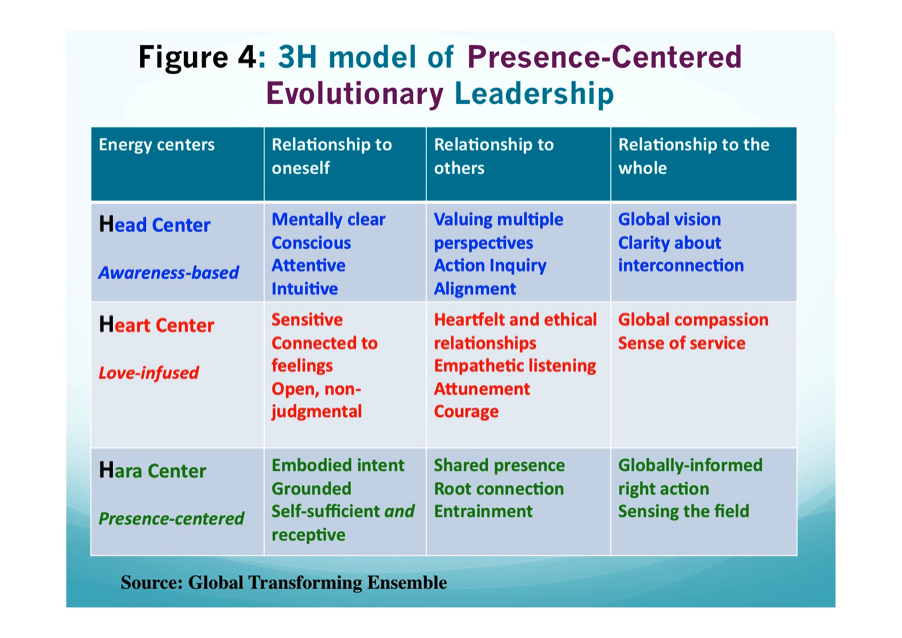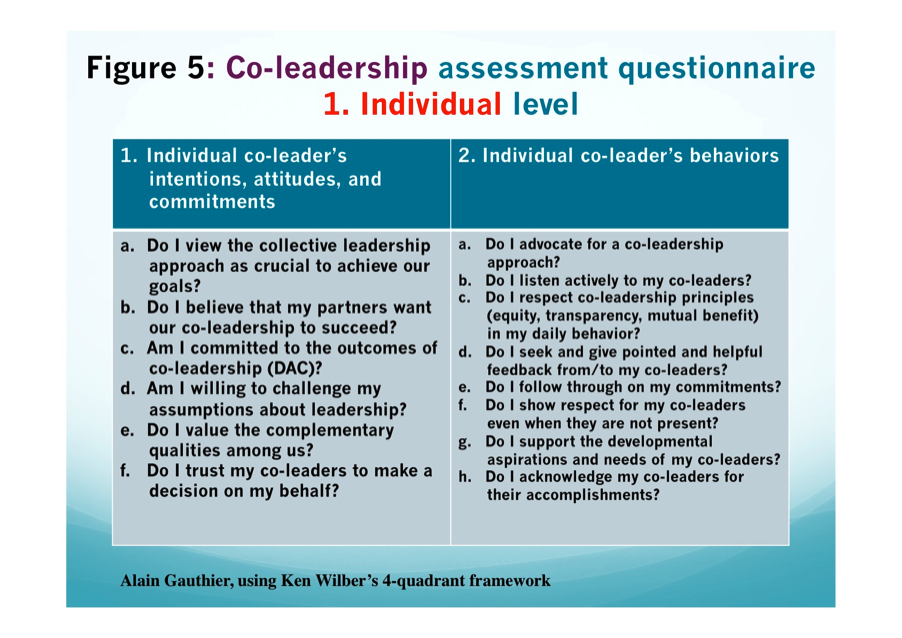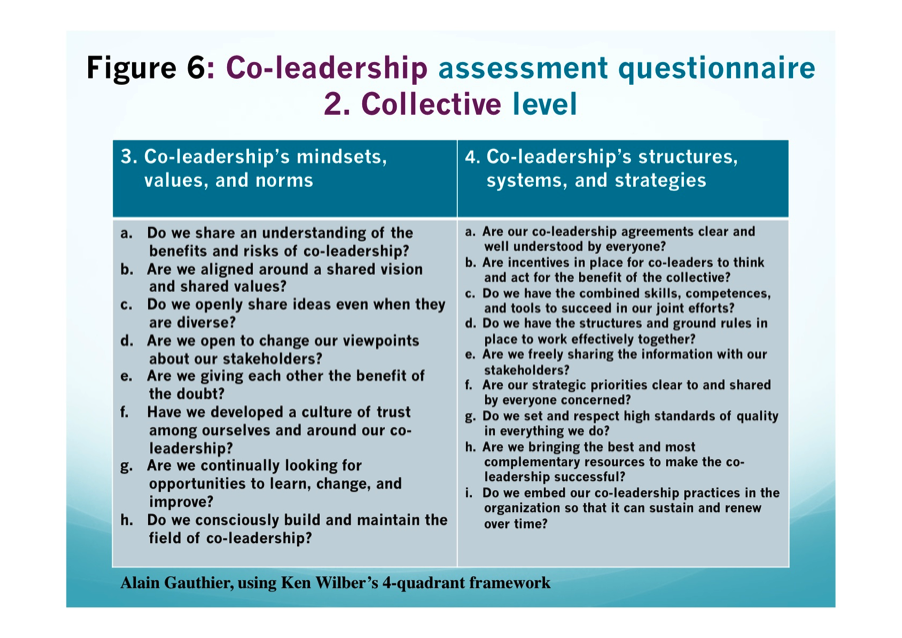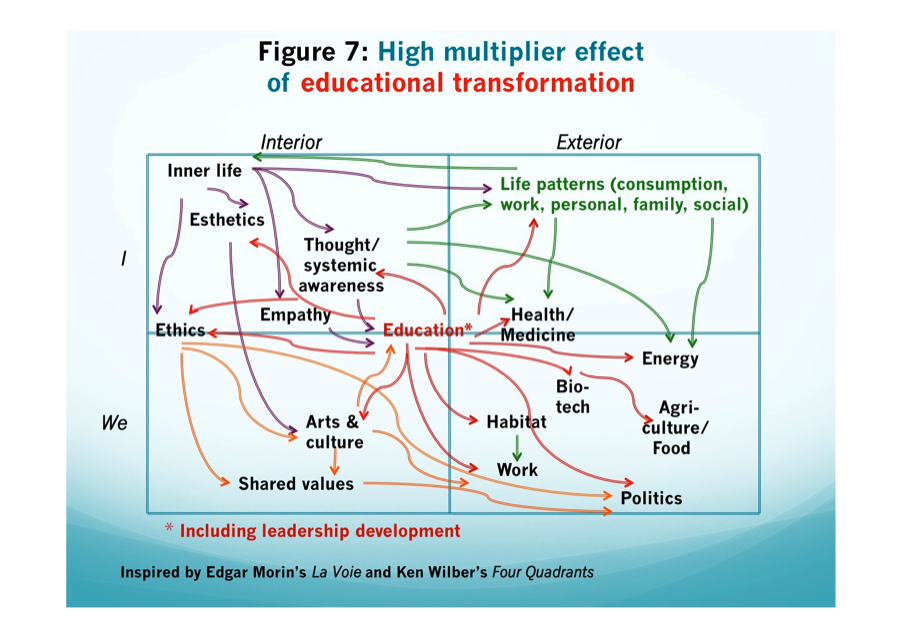Alain Gauthier
My intention in this article is to explore emerging concepts and forms of integral leadership, pursuing how they can be scaled up to bring humanity – across the planet – onto an evolutionary and sustainable course. After offering some fresh distinctions about leadership, the article calls for a shift to a radically innovative development model and points to key qualities and practices of evolutionary leadership. I then share some views on the multiplying effects of an integral approach to leadership development – in the context of a transformation of education – and conclude with some avenues to disseminate these emerging leadership forms, so as to deal constructively with what Barbara Marx Hubbard1 calls the current “birthing pains” of a new civilization.
New Distinctions about Leadership are Crucial Today
A profusion of articles and books have been written about leadership in recent years. But many of them do not make a clear distinction between authority and leadership, between authority and influence, or between executive leadership and distributed leadership. Authority is well adapted to solving technical or convergent problems (problems that have one solution), whereas leadership is required to address what E.F. Schumacher2 called “divergent problems” and Ronald Heifetz3 characterized as “adaptive challenges”.
When making fresh distinctions about a term, it is often useful to go back to its original etymology, especially when considering that the word “leadership” only exists in English and has been “imported” in other languages. The verb “lead” comes from the Indo-European root “leith”, which means to go forth, to cross a threshold, or even to die. What threshold needs to be crossed so that something new can emerge? What do leaders need to let go of, to die to, in order to cross that threshold? What if exercising leadership meant:
- Facing the unknown with openness and trust?
- Sensing what is emerging by being present to what is?
- Participating creatively in a wider field of knowing and doing, and giving a voice to an evolutionary impulse?
- Inviting self and others to new places – never seen/experienced before?
- Liberating the leadership capacity in everyone involved?
Crossing a threshold is the first step in the hero’s journey, according to Joseph Campbell4. Individual heroes are still needed today but, in the best case, one of their key roles is to invite many others to become “heroes” as well – on the path to exercising shared or collective leadership. Dying to one’s sense of “separateness” from the Source or from other human beings is to allow the essence of divinity in one’s heart and to become a distinct but unifying instrument of evolution and the collective greater good. To connect and give energy to the higher self and sacred being of another is to enact the true spirit of partnership or co-leadership, as musicians do in a jazz band or chamber orchestra without a conductor. In the Global Transforming Ensemble5, we call this “awareness-based, love-infused, presence-centered, evolutionary leadership”.
Current Global Crises Call for a Shift in the Prevailing Development Paradigm
What Edgar Morin6 calls poly-crises (financial ‘casino’, hyper-debt, economic disparity and instability, job-less recovery, ecological threats, widening gap between rich and poor, etc.) can be viewed as interconnected facets of a deeper and systemic crisis of development.
Our prevailing development paradigm is based largely on masculine/ patriarchal values, with four self-reinforcing building blocks:
- A view of human nature: one that is materialistic, driven by libido, instant gratification, utility, aggressiveness, and separate from nature. That view is at least a century old, and was popularized by Freud and others.
- A domination paradigm: domination of the many by a few, of the weak by the strong, of women by men, of nature by humans, of sensitivity by reason, of quality of life by work, of local cultures by colonizers. Some aspects of this paradigm are as old as agriculture and patriarchy; others are only a few centuries old.
- The quest for ongoing material growth: can be seen through quantitative measures of progress, consumerism, glorification of greed, scarcity mentality, globalization, objectification of nature and other humans, as well as disregard/externalization of social and environmental costs. This quest started in Europe with the merchants in the Renaissance period and has become generalized in modern times. Dependence on a single currency issued by a central bank in each country has created or reinforced the sense of scarcity and competition for resources.
- Blind faith in free markets: markets are deemed best to “regulate” the economy and adjacent domains – which leads to unrestrained financial capitalism and speculation, economy as war, externalization of ecological and social costs, political plutocracy, market- and performance-driven education, and privatization of healthcare and other public services or benefits. All of this has become a Western ideology in the last 30 years, largely exported through globalization.
This largely unquestioned development model – and the corresponding growth in the number and influence of MBAs and modern economists in the last 30 years – has led to a hypertrophy of the economy, at least in most western countries. Many people were led to believe that the economy would bring progress into their lives and it did so for a while. In Europe, we moved 300 years ago from an “economy of salvation” (where people could buy papal indulgences to redeem their sins) to “salvation by the economy” (where people could buy happiness in this world). But now the economy has invaded and damaged the geosphere (over-exploitation of non-renewable resources), the biosphere (deforestation, degradation of arable soil, air and water pollution, climate change), the political sphere (growth of influential lobbies and corruption), and the cultural sphere (loss of independence of mass media, education, the arts, and degradation of family life).
A radically new development paradigm is needed NOW – one that is not based on ever-increasing material growth, but on long-term sustainability and broader measures of individual and collective well-being. This new paradigm offers a better balance between masculine (Yang) and feminine (Yin) values, and has the following foundations:
- A new view of human nature as empathetic7, relational, affectionate, cooperative, searching for meaning, looking for differentiation and integration, agency and communion, or singularity and collaboration. While acknowledging the shadow side of human nature, it represents a major shift from a materialistic, individualistic, and reductionist view of humans to a humanistic, holistic, and spiritual one.
- A partnership paradigm8: where a person considers and treats others as equivalent (i.e. having equal value), generates trust through mutuality, favors flatter or circular structures with a “holarchy of actualization” (i.e. governance by the wise), and weaves stories that honor partnership and shared leadership as normal. This new paradigm has been gaining ground, at least in Western countries, with the increasing number of “cultural creatives” and women in influential roles, and the rapid growth of civil society organizations and social enterprises.
- A quest for sustainable development or sustainability: while acknowledging the need to meet people’s basic material needs, the call for voluntary simplicity and measures of well being – such as Bhutan’s “Gross National Happiness” – is being heard around the world by a growing minority of people. In the same vein, a number of consultants and economists have been proposing a richer blend of quantitative and qualitative measures of development at both organizational and societal levels. At least five thousand complementary currencies are now used in communities around the world; with their emphasis on local exchange of value, they represent the seeds of a monetary ecology that would be much more resilient than the current system9.
- A balanced use of markets and regulation: the downfalls of speculative companies and financial market crises in the last few years have led to increasing criticism of the free-market ideology. The need for both national and international regulation is more widely expressed. More generally, there is a growing recognition – including among economic leaders – that simplistic and individualistic mechanisms, based on Adam Smith’s concept of the “invisible hand”, are not adapted to today’s global increasing complexity.
Wide adoption of this emerging paradigm depends on the level of awareness and collaboration of leaders across various sectors of society: private, public, civil, education, and media. Through their own exemplary behavior as well as cultural and structural innovations, leaders can create conditions for many others to expand their own consciousness and find ways to experience a more encompassing sense of abundance in their life. Breakthrough forms of leadership development are critical for the diffusion of the new paradigm, within the context of a radical reform or transformation of education.
New Qualities and Practices Characterize Integral Evolutionary Leadership
In response to the poly-crises and to the opportunity for radical rethinking of our prevailing development model, new concepts and forms of leadership are emerging in a number of organizations and communities around the world.
1. Recent leadership literature reflects this emergence by pointing to new leadership concepts and forms:
- Shared/distributed/rotating/collective leadership – which acknowledges lateral or peer influence and engages in consultation and coordinated action.
- Leadership as a relational process rather than a position – emphasizing interpersonal influence, dialogue and mutuality.
- Complexity leadership – including quantum entanglement, “chaordic” principles, as well as simultaneous top-down, bottom-up, diagonal, and circular change processes.
- Partnering across organizational and/or sectoral boundaries – such as in open innovation and balanced cross-sector alliances for sustainable development.
In the context of shifting from a domination to a partnership paradigm, new leadership practices are adopted by a growing number of leaders in areas such as mutual adjustment, shared sense-making, collective learning and intelligence.
2. Shared or collective leadership challenges the traditional distinction between leaders and followers who agree on a few shared goals. In these emerging forms, co-leadership produces three outcomes as means to attain longer-term goals10:
- Direction: understanding and affirming the value of the collective’s goals
- Alignment: organizing and coordinating knowledge and work
- Commitment: members subsuming their own efforts and benefits within the collective effort and benefit.
To produce these outcomes, leaders need to examine their beliefs about both individual and collective leadership and engage in practices that will create a new leadership culture.
3. The action research undertaken jointly by the Global Transforming Ensemble and the Institute for Strategic Clarity11 shows that members of vibrant organizations or communities – which reach a high level of well-being, sense of abundance, or “harmonic vibrancy” – experience a high quality of relationship along five dimensions simultaneously:
- Relationship to self (freedom for self-expression)
- Relationship to others in the group (mutuality)
- Relationship to the larger human community (contribution to the collective, service, care)
- Relationship to nature (respect and balance)
- Relationship to spirit (meaning and evolution).
When the dynamics of harmonic vibrancy are at work, there are several positive reinforcing loops (across the four quadrants) that connect ability to self-sustain, ability to self-determine, cultural identity, effectiveness of social structures and processes, strength of the social fabric, and available economic opportunities.
Initial survey results of 600 communities – followed in some cases by in-depth interviews with several members – show that the level of harmonic vibrancy in the collective is influenced by the quality of leadership that can be characterized by several interior conditions:
- Being personally aware of one’s own attitude and behavior.
- Paying attention to the quality of relationship with self, others, nature, and the larger human community.
- Experiencing a sense of profound interdependence.
- Valuing diverse and complementary views, gifts, and skills.
- Having a beginner’s mind, being humble and willing to learn, with a sense of humor and playfulness.
- Willing to partner.
- Being of service.
- Opening to inspiration and guidance from the larger field.
- Trusting life’s process and evolution.
The Global Transforming Ensemble’s 3H model of presence-centered, evolutionary leadership clusters a number of these qualities around three subtle energy centers: Head, Heart, and Hara – in relationship to self, others, and the whole. Each center corresponds to an aspect of the emerging forms of evolutionary leadership we observe in the field: awareness-based, love-infused, and presence-centered.
4. Leadership practices at three levels (personal, interpersonal, and systemic) can reinforce each other. They support personal and organizational transformation, and give access to internal guidance and collective wisdom:
a. Personal practices include various forms of individual action inquiry that enable a person to lead an
intentional life and to develop as a learning, exemplary leader:
- Journaling, auto-biographical writing
- Distinguishing between desires and intentions
- Surfacing and challenging one’s beliefs and assumptions, by using tools such as the four-column conceptual map of Kegan and Lahey12
- Using self-awareness tools such as the Partnership Questionnaire Part 1
- Deepening one’s intuition and inner knowing through body-mind awareness practices, such as meditation, chi-gong, martial arts or improvisation
- Seeking coaching or mentoring, role-playing, co-development, support from a peer group or network.
b. Interpersonal practices include multiple forms of collaborative inquiry:
- Practicing high-quality advocacy and inquiry, as well as reflective and generative dialogue
- Practicing compassionate confrontation (or “tough love”)
- Addressing conflicts as opportunities to learn
- Applying systems thinking archetypes to complex issues
- Working creatively with dilemmas and paradoxes by using tools such as the polarity map13
- Using and sharing collective diagnosis tools such as the Team Performance Curve14 or the Partnership Questionnaire – Part 2
- Practicing reflective and creative forms of speaking, listening, and interacting in a team or peer group
- Engaging in joint experiences that nurture moment-to-moment awareness such as improvisational theater
- Seeking team or network coaching
- Undertaking intercultural journeys in a small group.
c. Systemic practices include:
- Building a shared vision with diverse partners and stakeholders – as a prerequisite for profound organizational change – and working with creative tension between vision and reality at various levels in an organization.
- Bringing the whole system (or a microcosm of it) “in the room” in order to deal effectively with social, dynamic and generative dimensions of complexity and find emerging solutions with all key stakeholders15.
- Setting up the conditions and processes for open innovation (upstream, downstream and sideways) that combines singularity and collaboration.
- Partnering across sectors (public, private, civil society) to launch and implement projects that can only be successful at that level of collaboration16.
Integral Leadership Development has a High Multiplier Effect and is a Key Aspect of Educational Transformation
On a societal level, a transformation of education in all its aspects – education of parents, formal education K-12, higher and on-going education, management and leadership development, media programming – will offer the largest multiplying effects:
- In the interior/subjective quadrants, it will influence domains such as esthetics, ethics, systemic awareness, arts and culture, and shared values.
- In the exterior/observable quadrants, it will impact domains such as health/medicine, eating habits, energy uses, habitat, work, business practices, political choices and social networks.
However, that transformation requires a radical rethinking of education’s outdated premises – as well as the collaboration of many individual leaders and institutions – while building on the many alternative experiments that are already in existence and growing.
With a new view of human nature, a transformed education in its various forms will be both nurturing and challenging – through shared pedagogical experience and facilitative teaching. It will develop empathy and emotional maturity, appreciative inquiry and participative observation, collaborative learning, environmental and social literacy. It will enable every person to become more aware of his/her own true gifts and more willing to offer them in service to the community.
From a developmental perspective, this education will cultivate the ability to be present to what is, to adopt a systemic perspective, to search for both/and responses and solutions, to be at ease with ambiguity and paradoxes, and to feel responsible for authoring one’s life while caring for the whole. Liberating the capacity for self-education and developing a thirst for life-long learning will cultivate the conditions for leading an intentional life and embodying a new development paradigm as a leader.
Within that broader context, new designs for leadership developmenttake several dimensions into account:
- Using the four-quadrant integral framework to highlight less-explored domains of leadership beliefs and practices, such as challenging individual leadership beliefs, embracing paradoxes, adopting a service mindset, developing body intelligence, developing presence and intuition.
- Adopting a developmental perspective, at least when looking at the interior quadrants: intentions, beliefs, and mindsets, as well as cultural values and norms.
- Using instruments such as the Leadership Developmental Framework17 to identify individual levels of maturity and track its evolution over time.
- Refining, adapting and disseminating surveys to evaluate and monitor the developmental level of an organization18.
- Emphasizing skills and practices to co-create or deepen a co-leadership culture which includes learning at different levels: team, network, organization, across organizations and sectors.
- Embedding new ways of assessing, challenging, and supporting the development of leaders by framing individual behavior as participation in webs of beliefs and practices.
Scaling up Evolutionary Leadership to Serve a New Development Paradigm
Several avenues are already being pursued and could be widened and multiplied to disseminate new forms of leadership on a large scale in the next few years:
- Identify, connect, support, and showcase globally the many leaders who are already practicing new forms of leadership in social enterprises, best places to work, NGOs and other communities. Organizations and networks – such as the Global Transforming Ensemble, the Presencing Institute, the Berkana Institute, The World Café Foundation, The Art of Hosting, and the Buckminster Fuller Institute – are already doing work in that direction. Much remains to be done to leverage these initiatives on a global scale.
- Expand the number, reach, and interconnections of educational programs that are already developing integral or global leadership in a number of countries. The Global Leadership Network initiated a first survey of 27 such programs in 2007-2008, and the report on Global Leadership Development Programs19 highlights common characteristics, unmet needs, and some of the next steps that could be taken. Among those are the incorporation of more integral components in management schools and universities, the wider use of learning practice fields and games, the development of qualified teachers/facilitators, and the accessibility of programs to a greater number of underprivileged local leaders.
- Embed radically new content and pedagogy – based on the emerging paradigm of development – in world universities who are preparing young leaders in various fields for tomorrow. For example, the Giordano Bruno Globalshift University will start enrollment in the Spring of 2012 and plans to ultimately reach millions of young people from low-income families who, until now, could not dream of having access to accredited world-class higher education. The new system will combine an internet-based form of education with the traditional campus-based classical form by licensing programs to thousands of middle schools around the world. The educational methodology of the University is trans-cultural, interdisci-plinary, experiential, playful, addressing both left- and right-brain in a non-hierarchical mode – based on close and constant interaction among students and teachers. The core program will help students comprehend their world and transform it in light of their emerging insight and wisdom.
- Enhance communication, sharing of practices, coordination, and collaboration among respected organizations and networks across the fields of conscious evolution, peace, justice, social innovation, sustainability, and wise use of technology. The number and reach of such organizations have greatly increased in the last few years, but their influence on the dissemination and embodiment of a new development and leadership paradigm has often been limited by their lack of funding and management capability, as well as by the fragmentation of the field. To help reach a critical mass in terms of world audience and effectiveness, a co-creative process is about to be launched and fostered among the organizations that share similar values and are most open to cooperation. Based on a groundbreaking communication and collaboration platform, this initiative can allow a more effective use of the resources that are available and attract new funding within the 2012 timeframe – a year that may prove to be critical for birthing a civilization based on the emerging paradigm.
Conclusion
We are witnessing the end of a world as we have constructed it. Consider that three great waves are ending: 1) A 30-year wave of ultra-capitalism and hyper-consumption, which has been characterized by excesses, economic/social/ ecological imbalances, and the resulting ill-being for many. 2) A 300-year wave of modernity that has brought multiple freedoms and human/social rights, but also an objectification of nature and humans, as well as new forms of inhumanity. 3) A 3000-year “mental age” of humanity, characterized by a lack of balance between mental intelligence and body, heart, and soul intelligence20.
Fortunately, many signs of the swelling of a new wave are already visible – although not yet acknowledged by the mainstream media. And new forms of leadership are emerging that create conditions for people to “grow in humanity”. These developments combine the best of modernity and the best of indigenous societies into a new wisdom – in relationship to nature, community, and meaning. Through the wider adoption of individual and collective integral practices – as well as a transformed education – leadership everywhere can exemplify the deep interconnectedness between personal and societal transformation. It will encourage a qualitative development for all beings during this quantum jump in evolution.
End Notes and References
1 Barbara Marx Hubbard, The Shift from Ego to Essence, 2001.
2 E.F. Schumacher, A Guide for the perplexed, 1978.
3 Ronald A. Heifetz et al, The Practice of Adaptive Leadership – Tools and Tactics for Changing Your Organization and the World, 2009.
4 Joseph Campbell, The Hero with a Thousand Faces, 2008.
5 Global Transforming Ensemble, www.globaltransformingensemble.org.
6 Edgar Morin, La Voie, 2010.
7 Jeremy Rifkin, The Empathetic Civilization: The Race to Global Consciousness in a World in Crisis, 2009
8 Riane Eisler, The Power of Partnership: Seven Relationships that will Change Your Life, 2003.
9 Gwendolyn Hallsmith and Bernard Lietaer: Creating Wealth: Growing Local Economies with Local Currencies, 2010.
10 William Drath et al, Direction, Alignment, Commitment: Toward a More Integrative Ontology of Leadership, Leadership Quarterly, 2008.
11 http://blog.instituteforstrategicclarity.org/ and James Ritchie-Dunham, Ecosynomics, forthcoming.
12 Robert Kegan and Lisa Lahey, Immunity to Change: How to Overcome it and Unlock the Potential in Yourself and Your Organization, 2009.
13 Barry Johnson, Polarity Management: Identifying and Managing Unsolvable Problems, 1992
14 Jon Katzenback and Douglas Smith, The Wisdom of Teams: Creating the High-Performance Organization, 2003.
15 Adam Kahane, Solving Tough Problems: An Open Way of Talking, Listening, and Creating New Realities, 2007.
16 Alain Gauthier, Developing Collective Leadership – Partnering in multi-stakeholder contexts, in Leadership is Global: Co-creating a More Humane and Sustainable World, edited by Walter Link, Thais Corral, and Mark Gerzon, 2006.
17 Susanne Cook-Greuter, Post-Autonomous Ego Development: A study of its Nature and Measurement, 2010
18 William Torbert and Associates, Action Inquiry: The Secret of Timely and Transforming Leadership, 2004.
20 Patrick Viveret, Vers une Sobriété Heureuse (Toward a Happy Simplicity), 2009.
About the Author
Alain Gauthier is an international consultant, facilitator, coach, and educator who focuses his work on developing co-leadership and partnering capabilities in and across the public, private and civil society sectors. He is passionate about integrating the inner and outer dimensions of human experience, both at the individual and collective levels.
Alain is a senior associate of the World Café Community Foundation and has facilitated meetings on partnership capacity building in several African countries, as well as in Europe, Latin America and the United States.
A graduate from H.E.C. (Paris), Stanford University M.B.A., and former senior consultant at McKinsey & Company, Alain is currently Executive Director of Core Leadership Development in Oakland, California. Over the last 45 years, he has served a wide range of clients, from large American, European, and Japanese corporations to three UN Agencies, global foundations, healthcare and educational systems, as well as other organizations in the for-profit and non-profit sectors.
Alain has adapted and prefaced in French three of Peter Senge’s “Fifth Discipline” books, and is a co-author of “Leadership is Global” and “Action Inquiry: The Secret of Timely and Transforming Leadership”, as well as of two books on coaching and leadership development in French. He is a co-founder and active member of the Society for Organizational Learning (SoL) in the United States and France, a member of the Global Leadership Network, and a visiting professor for the Coaching/Personal Development Master’s Program at the Université Panthéon-Assas Paris II.


